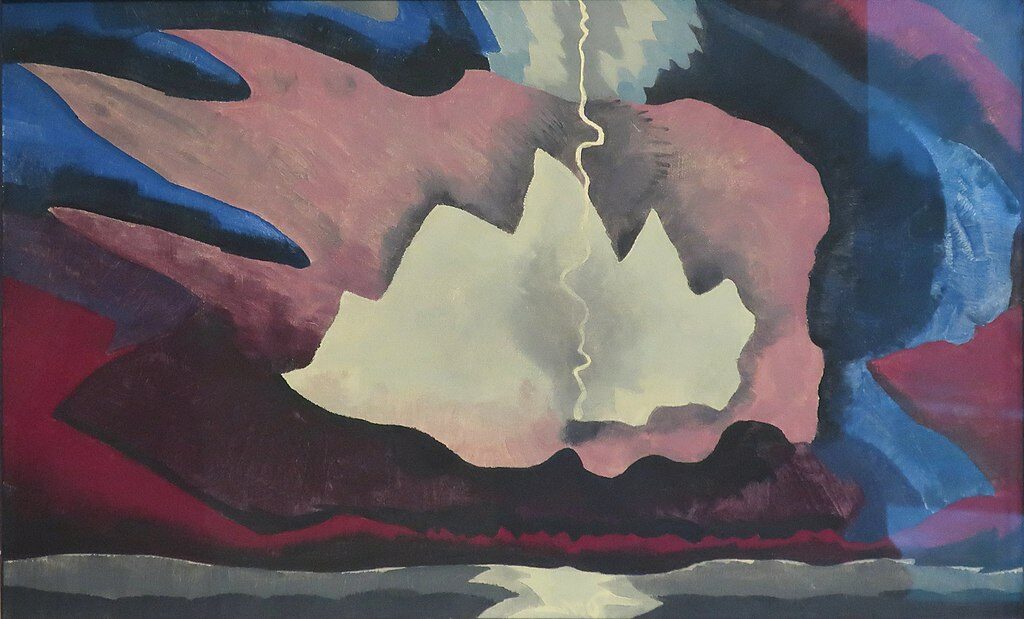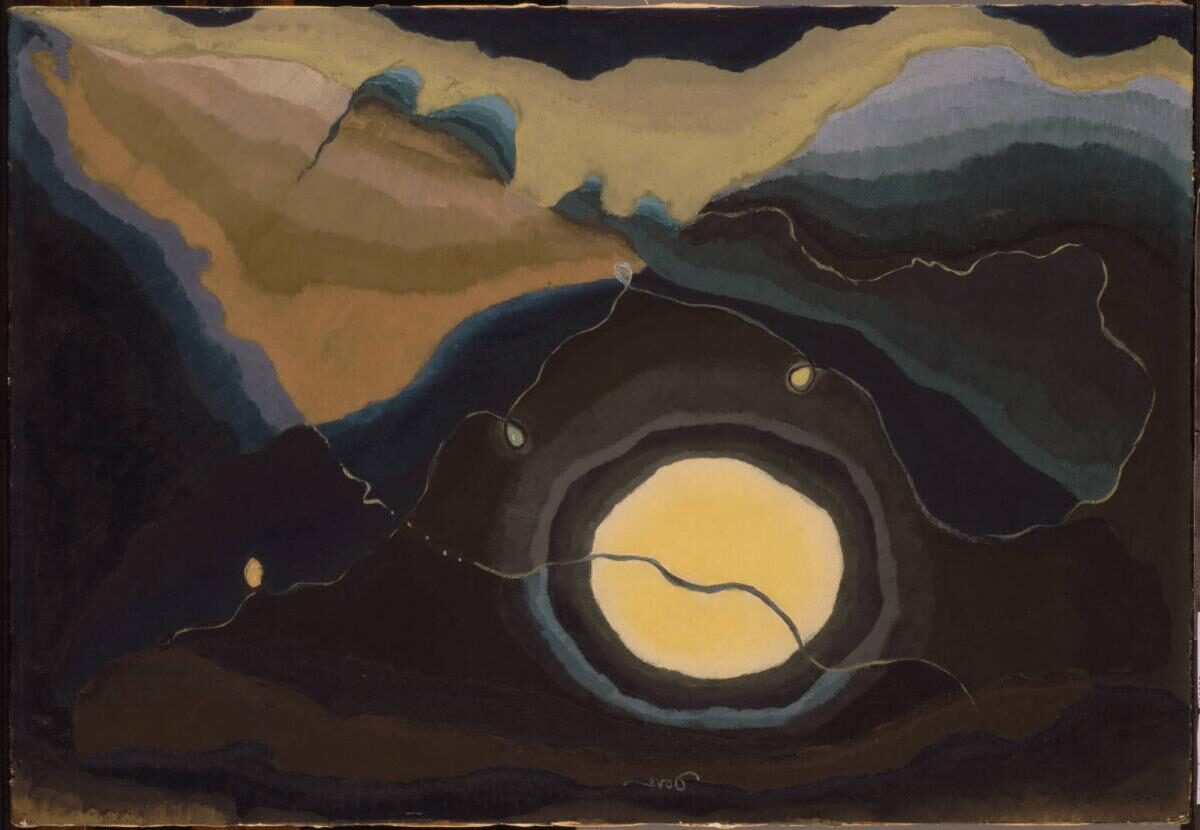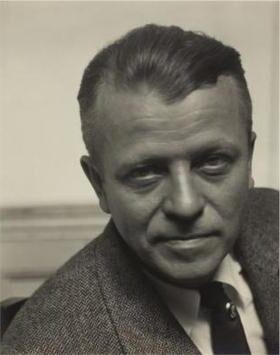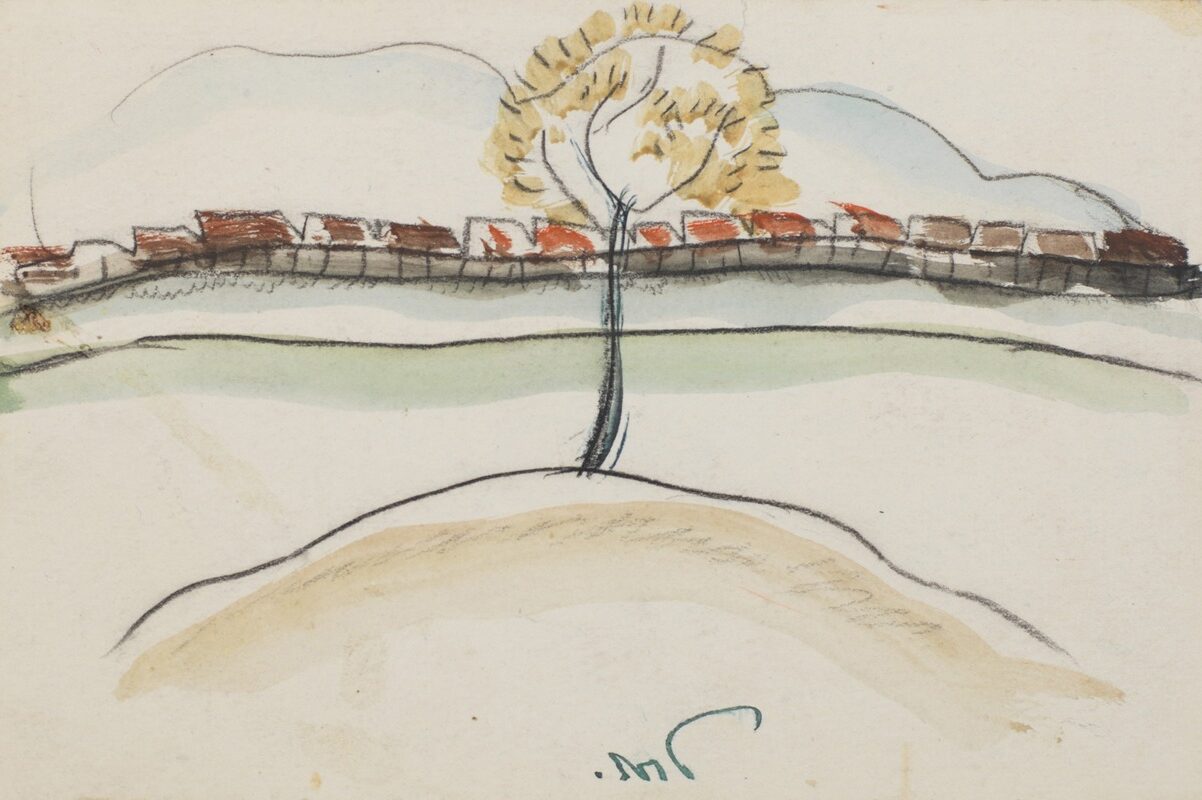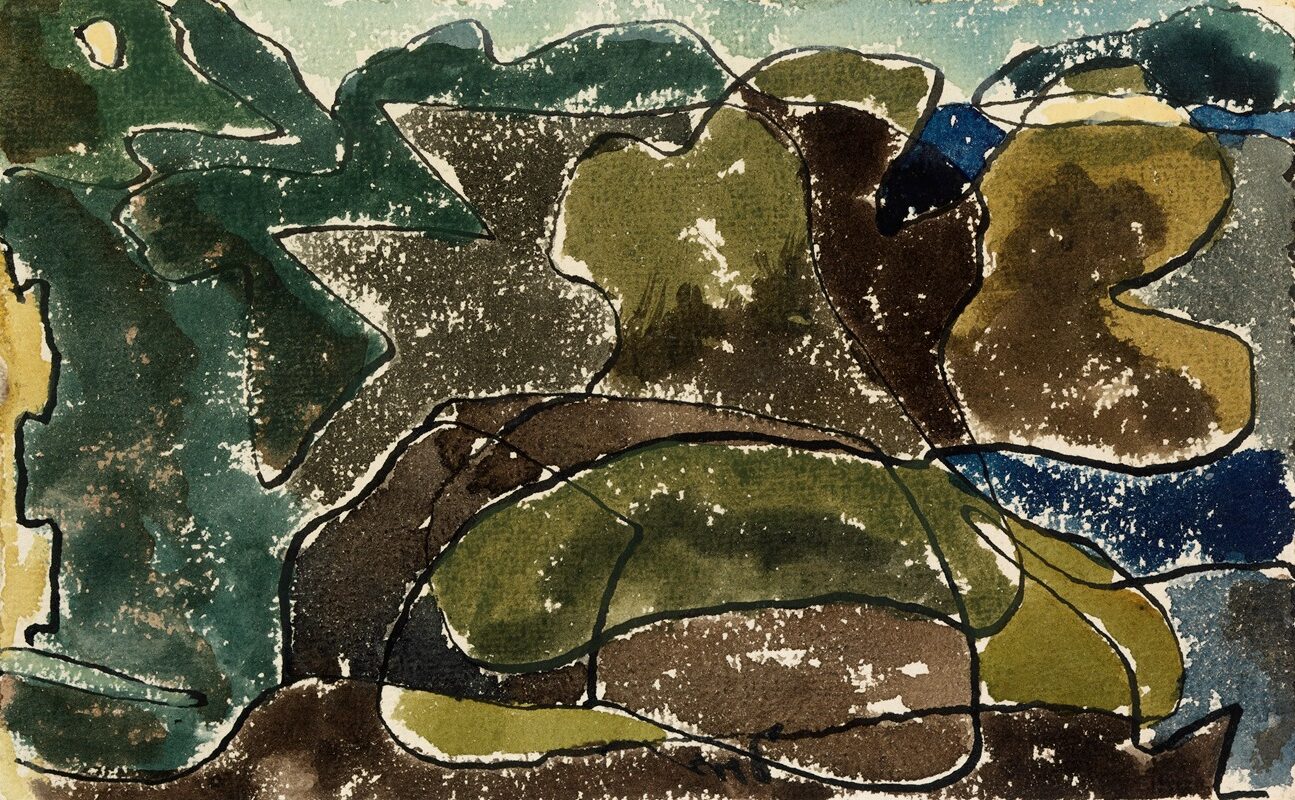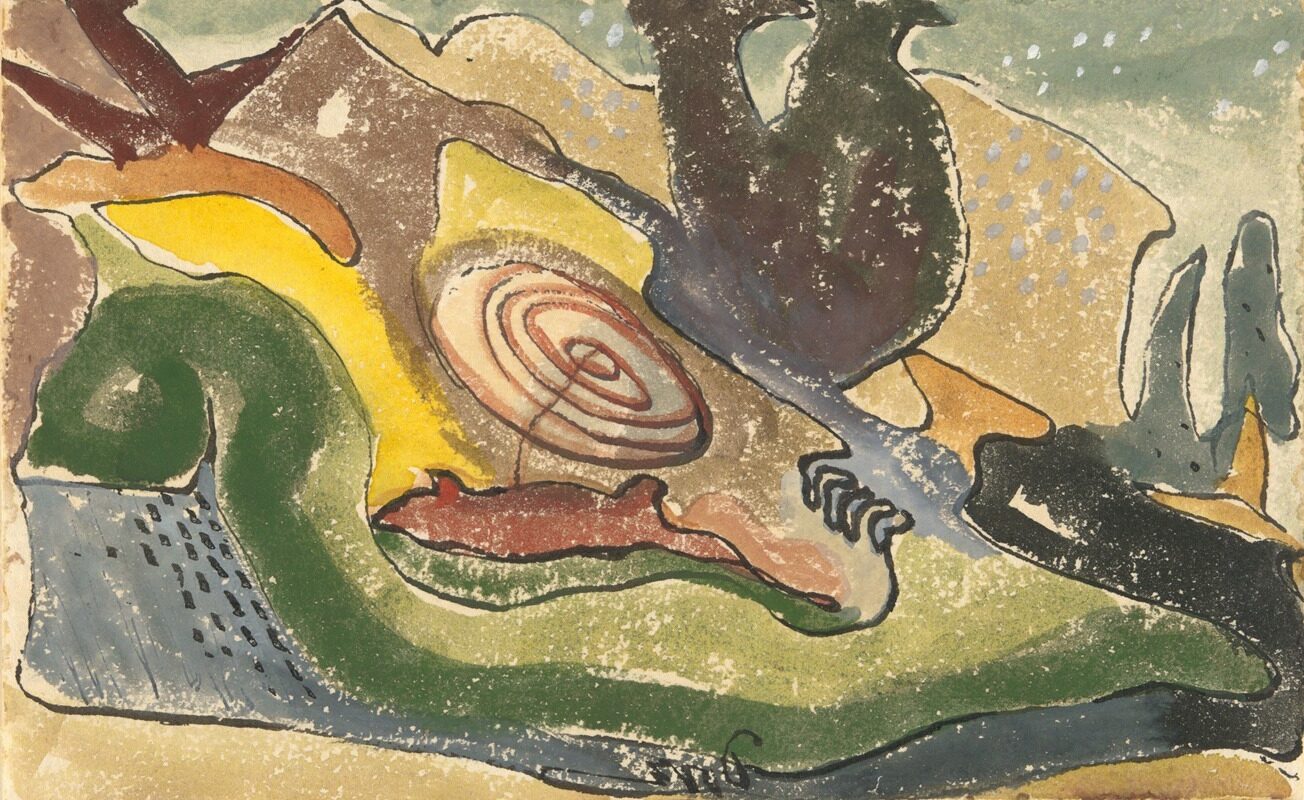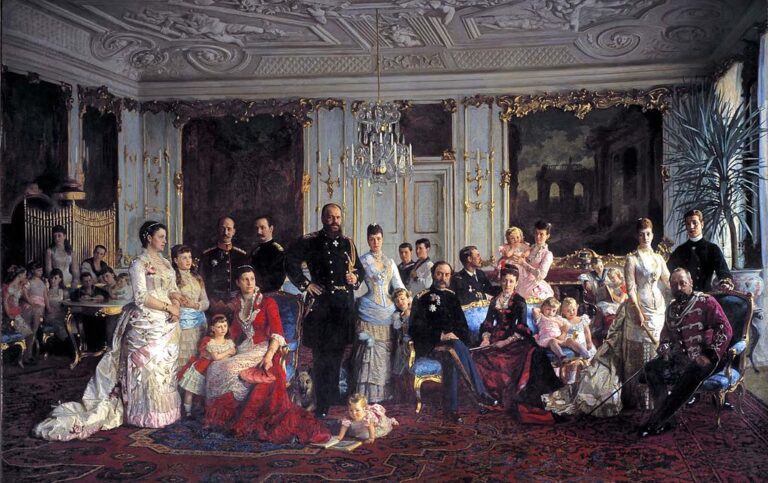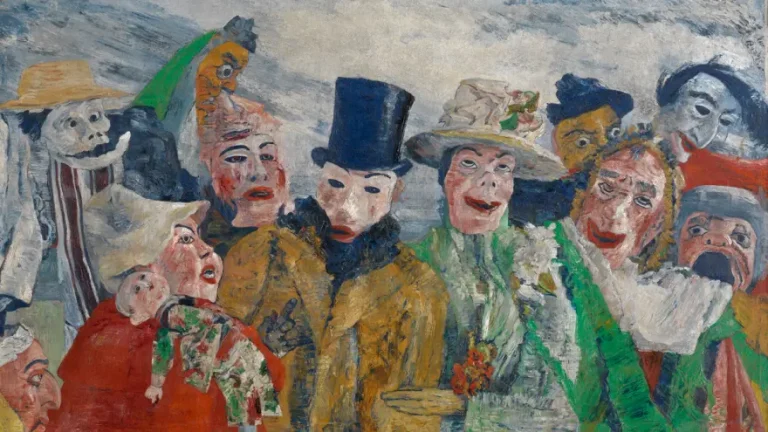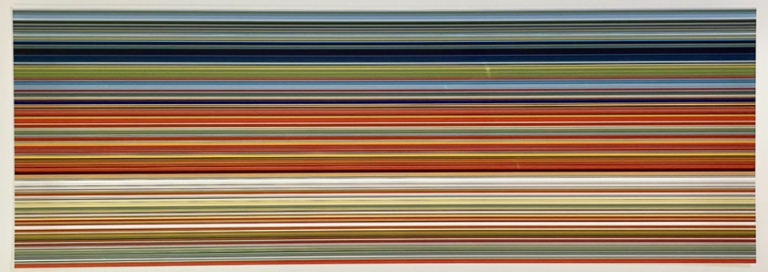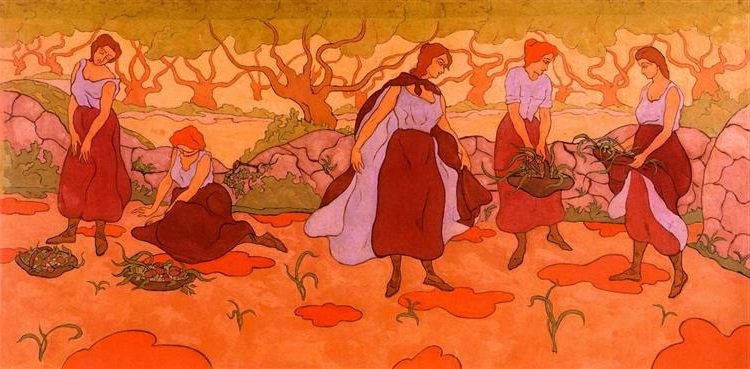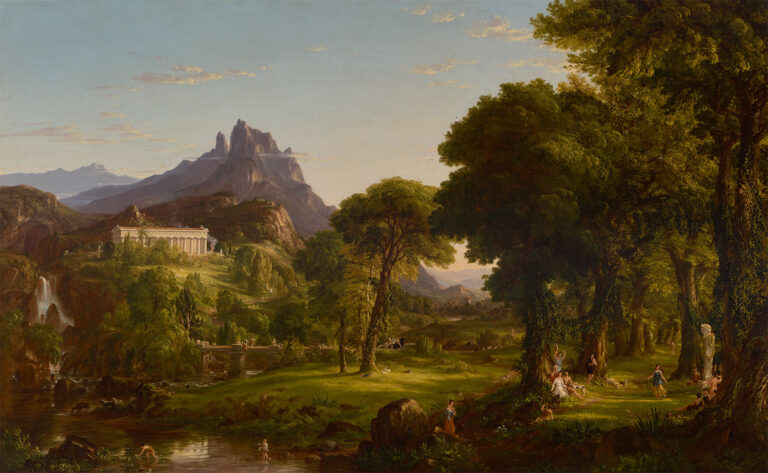Arthur Dove, Painter: A Pioneer of American Abstract Art
Born: August 2, 1880, Canandaigua, New York, US
Death: November 23, 1946, Huntington, New York, US
Art Movement: Modernism, Abstract Art
Nationalité : Américain
Institution: Hobart College and Cornell University
Arthur Dove, Painter: A Pioneer of American Abstract Art
Life and Career of Arthur Dove
Arthur Garfield Dove (August 2, 1880 – November 23, 1946) established himself as a pioneering American modernist painter. His artistic journey took him from traditional beginnings to becoming one of the first American abstract artists.
Vie et éducation précoces
Arthur Dove was born in Canandaigua, New York, and grew up in the nearby town of Geneva. His upbringing in the scenic Finger Lakes region likely influenced his lifelong connection to nature, which became central to his artistic vision.
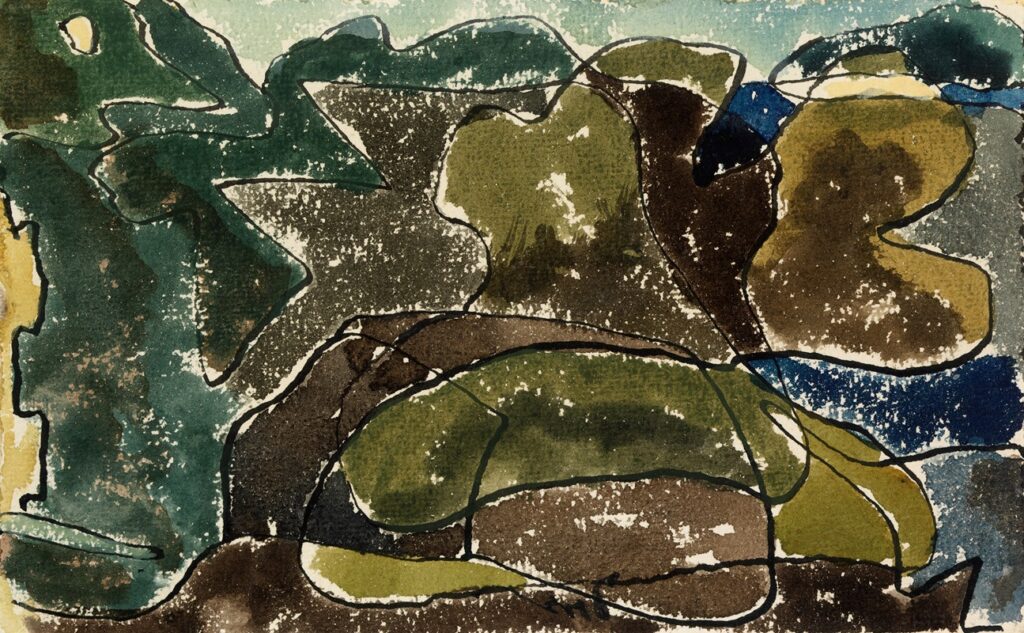
Over the Harbor, Centerport, 1942, by Arthur Dove
Dove attended Cornell University, where he studied law according to his father’s wishes. However, his true passion was art, and he worked as an illustrator for magazines while at Cornell.
After graduating in 1903, Dove pursued his artistic interests instead of law. He moved to New York City and worked as a commercial illustrator for publications. In 1907, he traveled to Paris, where he encountered European modernism firsthand.
Influence of Alfred Stieglitz
Alfred Stieglitz, the renowned photographer and gallery owner, became Dove’s most important professional relationship. In 1912, Stieglitz gave Dove his first solo exhibition at his 291 Gallery in New York.
Stieglitz continued to champion Dove’s work throughout his career. Through Stieglitz’s circle, Dove met other important American modernists including Georgia O’Keeffe, who became a lifelong friend and artistic peer.
Dove’s artistic development flourished under Stieglitz’s support. He created increasingly abstract works that translated nature into simplified forms and vibrant colors.
Despite financial struggles throughout much of his life, Dove remained dedicated to his artistic vision. He died in 1946 at Huntington Hospital on Long Island after years of heart problems.
Style artistique et contributions
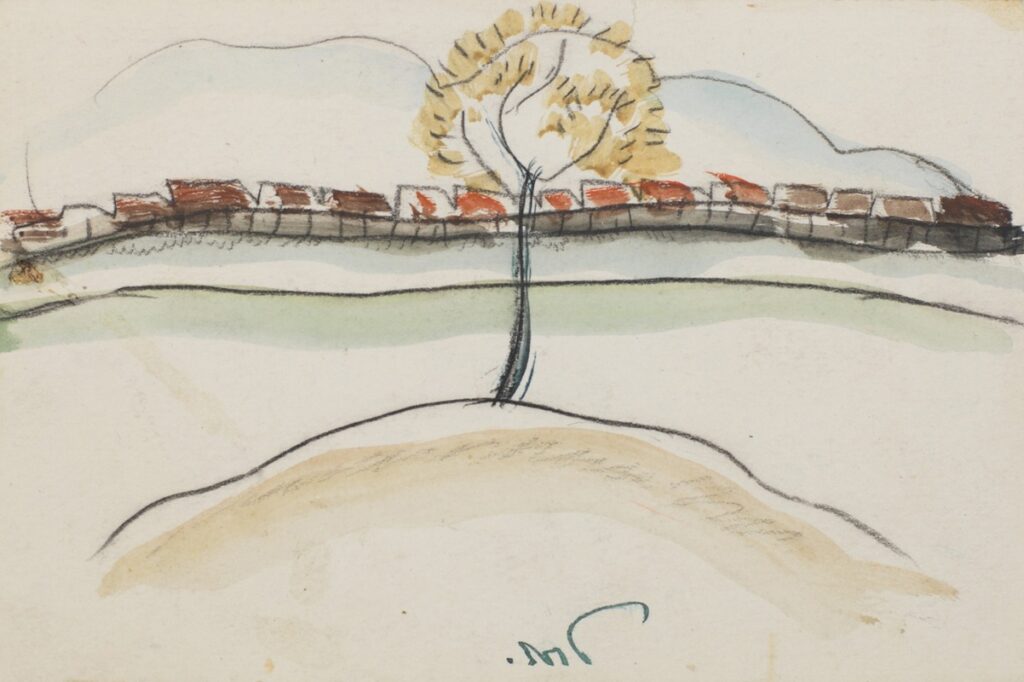
Fall Brook Railroad, circa 1934, by Arthur Dove
Arthur Dove developed a unique artistic style that revolutionized American art in the early 20th century. His techniques merged natural elements with abstract forms, creating a visual language that expressed both the physical world and emotional responses to it.
Abstract Painting and Modern Art Evolution
Dove is widely recognized as the first American abstract painter, pioneering new forms of expression that broke from représentation traditionnelle.
In 1910-1911, he created a series of abstract works that predated similar developments by many European artists. His approach to abstraction wasn’t about complete detachment from reality, but rather distilling subjects to their essential forms and energies.
Dove’s work bridged 19th-century American landscape traditions with modernist innovations. He used a distinctive palette of earth tones, blues, and greens that reflected his connection to nature while exploring modern concepts of form and color relationships.
His abstractions often featured curved, organic shapes and rhythmic compositions that suggested movement and natural forces. These elements became hallmarks of his unique contribution to modern art.
Nature Symbolized in Art
Dove’s deep connection to nature profoundly shaped his artistic vision. He frequently used natural phenomena—sun, moon, clouds, plants—as starting points for his abstract compositions.
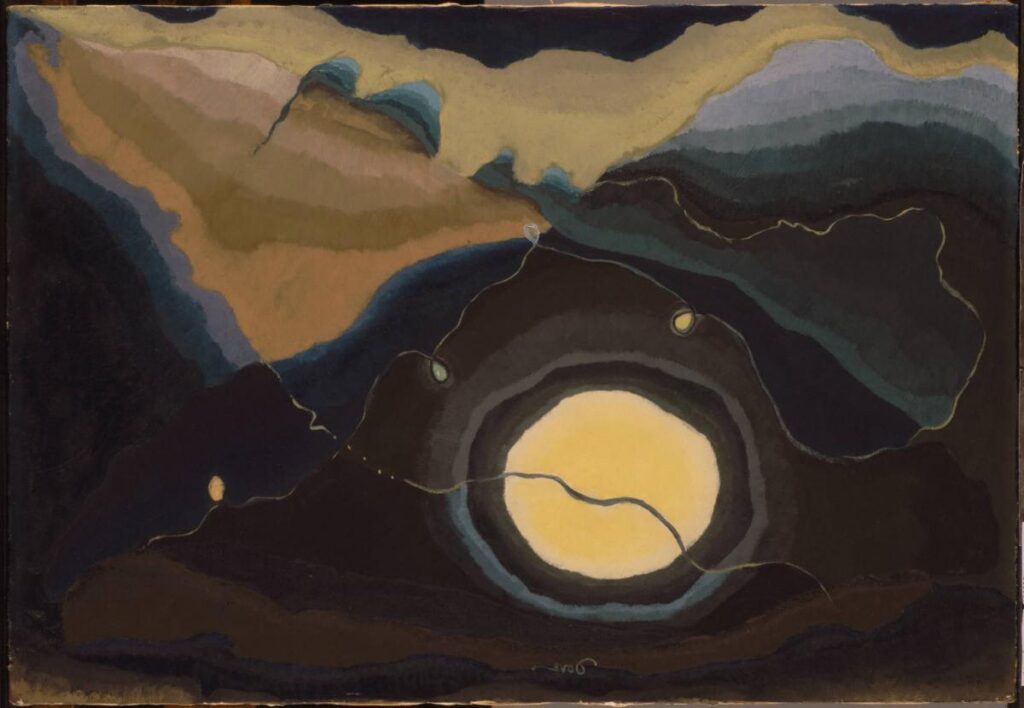
Me and the Moon, 1937, by Arthur Dove
In works like “Me and the Moon” (1937), Dove transformed personal experiences with nature into symbolic visual poetry. He didn’t merely depict landscapes but captured their underlying energies and rhythms.
His paintings often featured circular forms representing cosmic elements and undulating lines suggesting water, wind, or sound vibrations. These natural symbols created a visual language that communicated on both intellectual and emotional levels.
Dove developed innovative techniques to express nature’s textures, using unusual materials like hand-mixed oils, wax emulsions, and tempera. These experimental approaches allowed him to create surfaces that evoked natural elements in tactile ways.
Dove’s Culminating Works
In his later career, Dove refined his abstract language while continuing to draw inspiration from nature. His mature works achieved a perfect balance between abstraction and representation, creating what critics call “abstract landscapes.”
Dove’s experimentation with materials reached new heights in the 1930s and 1940s. He incorporated sand, metal, and wood into paintings, creating textured surfaces that added dimensional qualities to his work.
His late pieces often featured more geometric forms alongside organic shapes, showing his ongoing evolution as an artist. Works from this period display remarkable technical sophistication while maintaining emotional depth.
Dove’s culminating works represent the full realization of his artistic vision: expressing the spiritual essence of nature through abstraction. These paintings continue to influence contemporary artists interested in the intersection of abstraction and natural symbolism.
Héritage et expositions
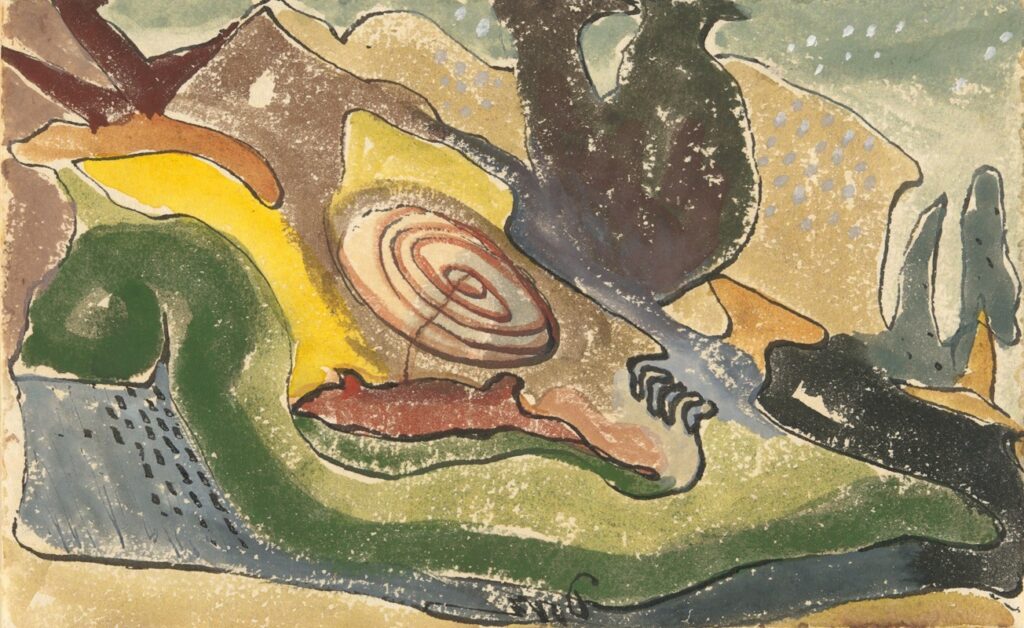
Beach, 1940, by Arthur Dove
Arthur Dove’s contributions to American art continue through carefully preserved collections and frequent exhibitions that showcase his pioneering abstract works. His paintings appear in prestigious museums where visitors can experience his unique interpretations of nature, sound, and light.
Preserving Dove’s Work
The Phillips Collection, founded by Duncan Phillips, houses one of the most significant collections of Dove’s artwork. Phillips recognized Dove’s importance early, becoming his patron in the 1920s and helping ensure the artist’s financial stability. By 1937, Dove’s health had declined, yet his work continued to evolve and gain recognition.
Many of Dove’s paintings depict the landscapes and natural elements he observed in upstate New York. His studio in Centerport became an important site for preserving his artistic legacy.
Art historians consider Dove’s interpretations of earth, weather, and sound revolutionary for their time. Conservation efforts focus on maintaining the vibrant colors and textures that characterize his abstract representations.
Collections and Public Display
The National Gallery of Art in Washington, DC holds several important Dove works in both its East Building and West Building. Visitors to the National Mall can view these pieces while exploring the area between Constitution Avenue and Madison Drive.
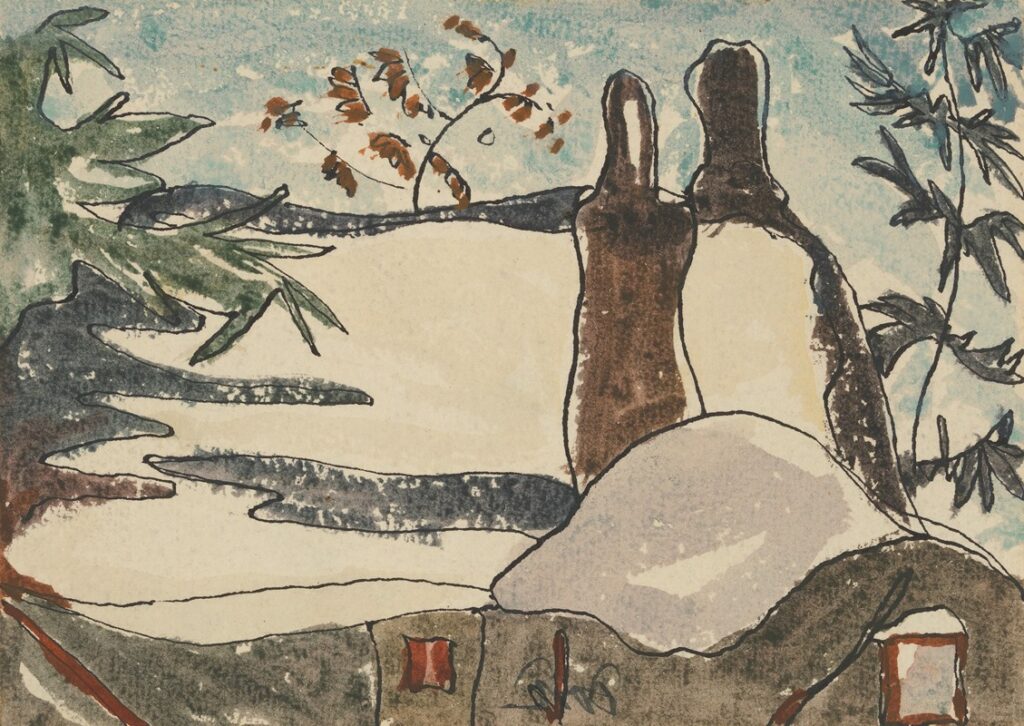
Snowy Rooftops and Trees, circa 1935, by Arthur Dove
Other major institutions displaying Dove’s work include the Whitney Museum of American Art and the Museum of Modern Art in New York. These collections allow the public to trace Dove’s artistic development from early experiments to mature abstractions.
Exhibitions often highlight how Dove translated natural phenomena into visual language. His paintings inspired later generations of American artists who expanded on his approach to abstraction.
Special retrospectives have traveled throughout the United States, introducing new audiences to Dove’s unique vision and cementing his place in art history.
Questions fréquemment posées
Arthur Dove’s artistic career sparked many questions about his techniques, influences, and iconic works. His pioneering abstract style introduced new approaches to American art that continue to fascinate viewers and scholars today.
What techniques did Arthur Dove employ in his watercolor paintings?
Arthur Dove approached watercolor with experimental techniques that set him apart from his contemporaries.
He often combined watercolor with other mediums like gouache or wax emulsion to create textural effects.
Dove frequently used a wet-on-wet technique, allowing colors to blend naturally on the paper. This created soft, atmospheric effects that captured natural phenomena like light, wind, and sound.
He also employed resist methods, sometimes using wax or oil to block areas from absorbing watercolor pigment. This technique helped him achieve luminous qualities in his abstract landscapes.
How did ‘Me and the Moon’ reflect Arthur Dove’s artistic style or philosophies?
‘Me and the Moon’ exemplifies Dove’s belief in the spiritual connection between humans and nature.
The painting reduces forms to essential geometric shapes while maintaining an organic quality.
The work demonstrates Dove’s synaesthetic approach, attempting to translate sensory experiences – like moonlight – into visual form. His use of radiating forms suggests the vibrational energy he perceived in natural phenomena.
The painting’s composition balances abstraction with recognizable elements, reflecting Dove’s philosophy that art should capture the unseen essences of things rather than their surface appearances.
Can you describe the use of contrast in Arthur Dove’s artworks?
Dove masterfully employed contrast to create dynamic tension in his compositions.
He often juxtaposed organic, curved forms against geometric, angular shapes to represent the intersection of natural and human-made worlds.
Color contrast was fundamental to his work, with bold combinations that enhanced visual impact. He frequently placed complementary colors adjacent to each other to increase vibrancy and emotional resonance.
Textural contrast appeared throughout Dove’s career as he combined smooth, flat areas with heavily textured surfaces. This approach added depth and tactile qualities to his abstract compositions.
What is the significance of the painting ‘Sun 1943’ within Arthur Dove’s body of work?
‘Sun 1943’ represents a culmination of Dove’s lifelong exploration of natural forces and celestial bodies.
Created near the end of his life, it showcases his mature style and technical mastery.
The painting demonstrates Dove’s ability to distill complex natural phenomena into powerful abstract forms. Its radiant composition captures both the physical presence and spiritual essence of sunlight.
‘Sun 1943’ reflects Dove’s enduring fascination with cycles in nature and cosmic energy. The work stands as a testament to his pioneering role in American abstract art and his unique vision of nature’s underlying rhythms.
What are the defining characteristics of Arthur Dove’s artistic style?
Dove’s style featured biomorphic abstraction that transformed natural subjects into simplified, organic forms. His compositions often balanced recognizable elements with pure abstraction.
Color played a crucial role in his work, with bold, expressive palettes that conveyed emotional and spiritual qualities. Dove frequently used color to suggest sound, movement, and other sensory experiences.
Textural experimentation defined much of his output, as he incorporated unconventional materials like sand, metal, and wax. This tactile approach gave his works a distinctive physical presence that enhanced their expressive power.
In what ways did European modernist movements influence Arthur Dove’s works?
Dove’s exposure to European modernism had a profound influence on his artistic development. He encountered Fauvism and early Cubism during his 1907-1909 Paris stay. From these movements, he adopted their emphasis on color and form over representation.
Kandinsky’s theories about spirituality in art also influenced Dove. His move toward pure abstraction was inspired by Kandinsky’s ideas. Both artists sought to capture invisible forces and spiritual essences through non-representational forms.
While influenced by European movements, Dove developed a distinctly American approach to abstraction. He created a modernist style grounded in his native environment. Dove drew inspiration from the American landscape and agricultural life.

